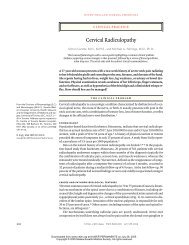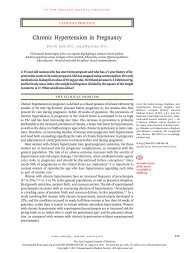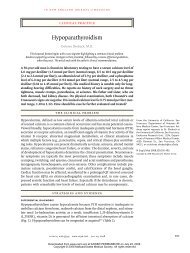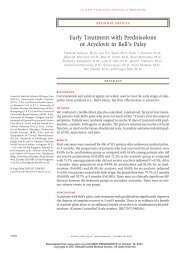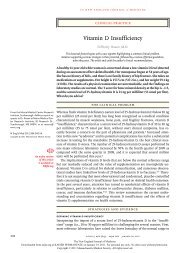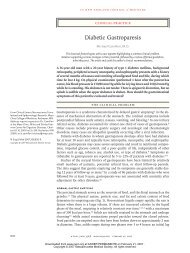Care of Transsexual Persons - Q-Notes for Adult Medicine
Care of Transsexual Persons - Q-Notes for Adult Medicine
Care of Transsexual Persons - Q-Notes for Adult Medicine
Create successful ePaper yourself
Turn your PDF publications into a flip-book with our unique Google optimized e-Paper software.
T h e n e w e ngl a nd j o u r na l o f m e dic i n e<br />
clinical practice<br />
<strong>Care</strong> <strong>of</strong> <strong>Transsexual</strong> <strong>Persons</strong><br />
Louis J. Gooren, M.D., Ph.D.<br />
This Journal feature begins with a case vignette highlighting a common clinical problem.<br />
Evidence supporting various strategies is then presented, followed by a review <strong>of</strong> <strong>for</strong>mal guidelines,<br />
when they exist. The article ends with the author’s clinical recommendations.<br />
A healthy and successful 40-year-old man finds it increasingly difficult to live as a<br />
male. In childhood he preferred playing with girls and recalls feeling that he should<br />
have been one. Over time he has come to regard himself more and more as a female<br />
personality inhabiting a male body. After much agonizing, he has concluded that only<br />
sex reassignment can <strong>of</strong>fer the peace <strong>of</strong> mind he craves. What would you advise?<br />
The Clinic a l Problem<br />
Gender identity is the sense one has <strong>of</strong> being male or female. 1,2 A significant incongruence<br />
between gender identity and physical phenotype is known as gender identity<br />
disorder; the experience <strong>of</strong> this state, termed gender dysphoria, 1 is a source <strong>of</strong><br />
chronic suffering. Manifestations <strong>of</strong> gender identity disorder range from simply<br />
living as a member <strong>of</strong> the opposite sex to partial or maximal physical adaptation<br />
through hormonal and surgical treatment. For most transsexuals (about 66%), the<br />
disorder has an early onset, in childhood; <strong>for</strong> the remainder, it develops much later<br />
in life. 3 For this older group <strong>of</strong> patients, usually men, the transition to a new sex<br />
from one they have lived in <strong>for</strong> many years is particularly difficult. 4<br />
Traditionally, gender identity disorder has been viewed as a psychiatric condition,<br />
and it will probably retain its classification as such in the Diagnostic and Statistical<br />
Manual <strong>of</strong> Mental Disorders (DSM) (Table 1). 3,4 However, a substantial proportion<br />
<strong>of</strong> the transgender population does not have a clinically significant coexisting<br />
psychiatric condition, 2 and sex reassignment benefits this group. 5,6<br />
The cause <strong>of</strong> gender identity disorder is unknown. Postmortem studies <strong>of</strong> small<br />
numbers <strong>of</strong> male-to-female transsexuals have shown a typically female pattern <strong>of</strong><br />
sexual differentiation in two areas <strong>of</strong> the brain — the bed nucleus <strong>of</strong> the stria<br />
terminalis and the hypothalamic uncinate nucleus 7 — suggesting that gender<br />
identity disorder may be a sexual differentiation disorder affecting the brain. 8,9<br />
Gender identity disorder cannot be explained by variations in chromosomal patterns<br />
or identifiable hormonal abnormalities. 8 Nor is there convincing evidence that<br />
psychological factors (being exposed to certain family dynamics or being raised<br />
as a member <strong>of</strong> the opposite sex) cause this condition. 10 The diagnosis relies on<br />
assessment by a mental health pr<strong>of</strong>essional according to the criteria specified in<br />
the fourth edition (text revision) <strong>of</strong> the DSM (DSM-IV-TR) 4 (Table 1) and elaborated<br />
in clinical practice guidelines from the Endocrine Society. 11<br />
The estimated prevalence <strong>of</strong> adult transsexualism in the Netherlands has been<br />
stable over time, at a rate <strong>of</strong> 1 case per 11,900 men and 1 per 30,400 women 12 ;<br />
similar or lower rates have been reported elsewhere. Estimates <strong>of</strong> the prevalence<br />
in North America are less precise, but the number <strong>of</strong> persons seeking help <strong>for</strong><br />
gender identity disorder in North America has recently increased. 13 Among trans-<br />
From the Department <strong>of</strong> Endocrinology,<br />
VU University Medical Center, Amsterdam.<br />
Address reprint requests to Dr.<br />
Gooren at 72/1 moo1., T. Palan, A. Doi<br />
Saket, Chiang Mai 50220, Thailand, or at<br />
louisjgooren@gmail.com.<br />
N Engl J Med 2011;364:1251-7.<br />
Copyright © 2011 Massachusetts Medical Society.<br />
An audio version<br />
<strong>of</strong> this article<br />
is available at<br />
NEJM.org<br />
n engl j med 364;13 nejm.org march 31, 2011 1251<br />
The New England Journal <strong>of</strong> <strong>Medicine</strong><br />
Downloaded from nejm.org at KAISER PERMANENTE on March 30, 2011. For personal use only. No other uses without permission.<br />
Copyright © 2011 Massachusetts Medical Society. All rights reserved.
T h e n e w e ngl a nd j o u r na l o f m e dic i n e<br />
Table 1. Diagnostic Criteria <strong>for</strong> Gender Identity Disorder.*<br />
Strong and persistent cross-sex identification (not merely a desire <strong>for</strong> any perceived cultural advantages <strong>of</strong> being the<br />
other sex)<br />
Children (at least four criteria must be met)<br />
Repeatedly stated desire to be a member <strong>of</strong> the other sex or insistence on actually being a member <strong>of</strong> the other sex<br />
In boys, preference <strong>for</strong> cross-dressing or simulating female attire; in girls, insistence on wearing only stereotypically<br />
masculine clothing<br />
Strong and persistent preferences <strong>for</strong> cross-sex roles in make-believe play or persistent fantasies <strong>of</strong> being a<br />
member <strong>of</strong> the other sex<br />
Intense desire to participate in the stereotypical games and pastimes <strong>of</strong> the other sex<br />
Strong preference <strong>for</strong> playmates <strong>of</strong> the other sex<br />
Adolescents and adults (at least one criterion must be met)<br />
Stated desire to be <strong>of</strong> the other sex<br />
Frequent attempts to pass as the other sex<br />
Desire to live or be treated as the other sex lives or is treated<br />
Conviction <strong>of</strong> having the typical feelings and reactions <strong>of</strong> the other sex<br />
Discom<strong>for</strong>t with original sex or sense <strong>of</strong> inappropriateness in the role <strong>of</strong> that sex<br />
Children (at least one criterion must be met)<br />
In boys, assertion that penis or testes are disgusting or will disappear, assertion that it would be better not to<br />
have a penis, or aversion to rough-and-tumble play and rejection <strong>of</strong> male stereotypical toys, games, and activities;<br />
in girls, rejection <strong>of</strong> urinating in a sitting position, assertion that she has or will have a penis, assertion<br />
that she does not want to have breasts or menstruate, or marked aversion to normative feminine clothing<br />
Adolescents and adults (at least one criterion must be met)<br />
Preoccupation with getting rid <strong>of</strong> primary and secondary sex characteristics (e.g., request <strong>for</strong> hormones, surgery,<br />
or other procedures to physically alter sexual characteristics and simulate the other sex) or belief in<br />
having been born with the wrong sex<br />
No concurrent physical intersex condition<br />
Clinically significant distress or impairment in social, occupational, or other important areas <strong>of</strong> functioning<br />
* These criteria were adapted from the Diagnostic and Statistical Manual <strong>of</strong> Mental Disorders (DSM) (fourth edition, text<br />
revision). 4<br />
sexual adults, a male:female ratio (according to<br />
original sex) <strong>of</strong> 3:1 is common throughout the<br />
Western world 12 but not elsewhere (e.g., Japan<br />
and Serbia). 14,15 A male preponderance is also<br />
noted be<strong>for</strong>e puberty, but gender identity disorder<br />
in children <strong>of</strong>ten resolves, and in adolescents the<br />
ratio is closer to 1:1. 16,17 The subsequent increase<br />
in the male:female ratio is explained by the<br />
higher frequency <strong>of</strong> men with late-onset gender<br />
identity disorder. 12 <strong>Transsexual</strong>ism after early<br />
puberty is generally an unalterable condition. 5,16<br />
S tr ategies a nd E v idence<br />
General Principles <strong>of</strong> Treatment<br />
Pr<strong>of</strong>essional acceptance <strong>of</strong> transsexualism and<br />
its hormonal and surgical treatment has grown.<br />
Interventions are indicated only after comprehensive<br />
psychological assessment has confirmed<br />
not only that the DSM diagnostic criteria have<br />
been fulfilled but also that the patient meets the<br />
criteria <strong>for</strong> readiness to make the transition to<br />
the other sex (as detailed below). 11<br />
<strong>Persons</strong> with gender identity disorder may<br />
have unrealistic expectations about what being a<br />
member <strong>of</strong> the opposite sex entails. 1,11 Hormonal<br />
treatment should there<strong>for</strong>e be preceded<br />
and accompanied by an extended period (at least<br />
1 year) during which the patient lives full time<br />
as a person <strong>of</strong> the desired sex. This real-life experience<br />
is essential <strong>for</strong> providing insight into<br />
the new sex status, allowing the patient to become<br />
accustomed to the social interactions arising<br />
from it. 1,11 Such sex reassignment, by enabling<br />
the patient to experience life as a person<br />
<strong>of</strong> the subjectively appropriate sex, reduces gen-<br />
1252<br />
n engl j med 364;13 nejm.org march 31, 2011<br />
The New England Journal <strong>of</strong> <strong>Medicine</strong><br />
Downloaded from nejm.org at KAISER PERMANENTE on March 30, 2011. For personal use only. No other uses without permission.<br />
Copyright © 2011 Massachusetts Medical Society. All rights reserved.
clinical pr actice<br />
der dysphoria and improves social and sexual<br />
functioning. 2,18<br />
Hormonal Sex Reassignment<br />
The goals <strong>of</strong> hormonal treatment are to induce<br />
the development <strong>of</strong> the secondary sex characteristics<br />
<strong>of</strong> the new sex and to diminish those <strong>of</strong> the<br />
natal sex. 11 Prior hormonal effects on the skeleton<br />
and vocal cords cannot be reversed. No randomized<br />
trials have been conducted to determine<br />
the optimal <strong>for</strong>mulations and dosages <strong>of</strong> crosssex<br />
hormones. Treatment strategies resemble those<br />
used <strong>for</strong> hypogonadal patients 11 (see Table 1 in<br />
the Supplementary Appendix, available with the<br />
full text <strong>of</strong> this article at NEJM.org).<br />
Male-to-Female <strong>Transsexual</strong>s<br />
Hormonal therapy is prescribed <strong>for</strong> male-to-female<br />
transsexuals to induce breast <strong>for</strong>mation and a<br />
more female distribution <strong>of</strong> fat and to reduce<br />
male-pattern hair growth. 19 To achieve these<br />
goals, the biologic action <strong>of</strong> androgens must be<br />
almost completely neutralized. Administration<br />
<strong>of</strong> estrogens suppresses gonadotropin output<br />
and there<strong>for</strong>e androgen production, but combining<br />
this treatment with a progestational agent, a<br />
gonadotropin-releasing-hormone (GnRH) analogue,<br />
20 or other medications that suppress androgen<br />
action (e.g., cyproterone acetate, flutamide,<br />
nilutamide, or bicalutamide) appears to be<br />
more effective. 21<br />
Many estrogens are available. Ethinyl estradiol,<br />
although efficacious, should be avoided.<br />
When taken at the dosages required <strong>for</strong> sex reassignment,<br />
this agent has been associated with<br />
significantly increased risks <strong>of</strong> venous thrombosis<br />
22 and death from cardiovascular causes, 23 as<br />
compared with 17β-estradiol.<br />
Although progestins suppress androgen production,<br />
they have no role in the feminization <strong>of</strong><br />
the body and may have harmful metabolic effects;<br />
consequently, progestins should be discontinued<br />
after orchiectomy. 24 In postmenopausal women,<br />
progestins combined with estrogens increase<br />
the risk <strong>of</strong> breast cancer. 25 Men undergoing androgen-deprivation<br />
treatment <strong>for</strong> prostate cancer<br />
are at increased risk <strong>for</strong> features <strong>of</strong> the metabolic<br />
syndrome. 26 Studies assessing the metabolic<br />
effects <strong>of</strong> androgen deprivation and estrogen<br />
therapy in male-to-female transsexuals have<br />
shown that increases in visceral fat are associated<br />
with increases in triglyceride levels, insulin<br />
resistance, and blood pressure. 27,28 Available<br />
data from one large practice with a median follow-up<br />
<strong>of</strong> 18.5 years have not suggested an increased<br />
risk <strong>of</strong> death from cardiovascular causes<br />
with treatment 21,23 except among current users<br />
<strong>of</strong> ethinyl estradiol. Data from larger and longerterm<br />
studies are not available. 29 The effects <strong>of</strong><br />
treatment are listed in Table 2.<br />
Female-to-Male <strong>Transsexual</strong>s<br />
Treatment in female-to-male transsexuals is intended<br />
to induce virilization. 11 This includes malepattern<br />
hair growth, 19 the development <strong>of</strong> male<br />
physical contours, and the cessation <strong>of</strong> uterine<br />
bleeding. The principal hormonal treatment is a<br />
testosterone preparation (Table 1 in the Supplementary<br />
Appendix). Concomitant progestin therapy<br />
is nearly always needed when testosterone is<br />
administered transdermally, since serum testosterone<br />
levels are lower with transdermal administration<br />
than with intramuscular administration,<br />
lessening suppression <strong>of</strong> gonadotropins.<br />
Long-Term Treatment<br />
After sex-reassignment surgery, including gonadectomy,<br />
hormonal therapy must be continued. 11,21<br />
Some male-to-female transsexuals continue to<br />
have male-pattern hair growth; continued administration<br />
<strong>of</strong> antiandrogens, typically at only about<br />
half the preoperative dose, reduces male-pattern<br />
hair growth. Continued administration <strong>of</strong> crosssex<br />
hormones is required to avoid symptoms and<br />
signs <strong>of</strong> hormone deficiency, such as vasomotor<br />
symptoms and, in particular, osteoporosis. Observational<br />
studies have shown that bone mass is<br />
generally maintained with estrogen alone in maleto-female<br />
transsexuals and with testosterone alone<br />
in female-to-male transsexuals when prescribed<br />
at the doses typically used to treat hypogonadism.<br />
30 Sufficient intake <strong>of</strong> calcium and vitamin D<br />
is also recommended. A blood concentration <strong>of</strong><br />
serum luteinizing hormone in the normal range<br />
is a reliable marker <strong>of</strong> adequate dosing. If sexreassignment<br />
surgery has taken place, the usual<br />
prescribed dose <strong>of</strong> estradiol in male-to-female<br />
transsexuals is approximately 50 µg per day and<br />
that <strong>of</strong> testosterone in female to-male transsexuals<br />
is typically the same as that used preoperatively:<br />
200 to 250 mg every 2 weeks in parenteral<br />
<strong>for</strong>m or 5 to 10 g per day in gel <strong>for</strong>m. 30 Table 2<br />
n engl j med 364;13 nejm.org march 31, 2011 1253<br />
The New England Journal <strong>of</strong> <strong>Medicine</strong><br />
Downloaded from nejm.org at KAISER PERMANENTE on March 30, 2011. For personal use only. No other uses without permission.<br />
Copyright © 2011 Massachusetts Medical Society. All rights reserved.
T h e n e w e ngl a nd j o u r na l o f m e dic i n e<br />
lists the potential side effects <strong>of</strong> sex steroids and<br />
recommendations <strong>for</strong> monitoring.<br />
Risks and Contraindications<br />
A serious concern regarding long-term administration<br />
<strong>of</strong> cross-sex hormones is the possibility <strong>of</strong><br />
an increased risk <strong>of</strong> hormone-dependent cancers.<br />
31 There are rare case reports <strong>of</strong> prolactinomas,<br />
breast cancers, and prostate carcinomas in<br />
male-to-female transsexuals and rare reports <strong>of</strong><br />
ovarian carcinoma, breast cancer, and vaginal<br />
cancer (one each <strong>of</strong> the latter two, to my knowledge)<br />
in female-to-male transsexuals. 31 Rare cases<br />
<strong>of</strong> hormone-dependent tumors in organs other<br />
than the reproductive organs (e.g., lung, colon,<br />
and brain [meningioma]) have also been reported<br />
in transsexuals who have undergone estrogen<br />
treatment. 31 Evidence is lacking to indicate a significantly<br />
increased frequency <strong>of</strong> cancers in association<br />
with cross-sex hormonal treatment, but<br />
the available data are from studies that involved<br />
relatively short-term exposure. Risks may become<br />
more apparent as subjects age and the duration<br />
<strong>of</strong> hormone exposure increases. 31 Because a portion<br />
<strong>of</strong> administered testosterone is aromatized<br />
to estradiol, female-to-male transsexuals who<br />
have not undergone breast removal and oophorectomy–hysterectomy<br />
should be monitored <strong>for</strong><br />
estrogen-sensitive cancers <strong>of</strong> the breast, endometrium,<br />
and ovaries. 31 Although the addition <strong>of</strong> a<br />
progestin may help to prevent endometrial cancer,<br />
studies <strong>of</strong> postmenopausal hormone use<br />
suggest that this therapy may increase the risk <strong>of</strong><br />
breast cancer. 25,32 It has also been reported that<br />
testosterone may contribute to the development<br />
<strong>of</strong> breast 33 and endometrial 34 cancer; there<strong>for</strong>e,<br />
monitoring <strong>of</strong> female-to-male transsexuals <strong>for</strong><br />
such cancers is also prudent. <strong>Transsexual</strong>s may<br />
not always be <strong>for</strong>thright with physicians about<br />
their sex change, and this hesitancy can lead to<br />
delays in diagnosing cancers <strong>of</strong> organs specific<br />
to the <strong>for</strong>mer sex.<br />
Table 2. Recommendations <strong>for</strong> Clinical Assessment and Follow-up during Treatment with Cross-Sex Hormones.<br />
Male-to-female and female-to-male transsexuals<br />
Rule out or treat coexisting conditions; address possible overdose <strong>of</strong> cross-sex hormones, substance abuse, depressive<br />
disorders<br />
Measure bone mineral density and assess <strong>for</strong> osteoporosis at baseline with the use <strong>of</strong> dual energy x-ray absorptiometry<br />
(DEXA), repeating every 1 or 2 yr thereafter if additional risk factors develop or patient stops taking hormones;<br />
determine whether there is a personal or family history <strong>of</strong> osteoporosis (prior fractures); prescribe dosages <strong>of</strong><br />
sex hormones that are adequate to preserve bone mineral density achieved in male-to-female transsexuals with<br />
estrogen administration and in female-to-male transsexuals with aromatization <strong>of</strong> testosterone to estrogen; use<br />
the eugonadal range <strong>of</strong> serum luteinizing hormone as an indicator <strong>of</strong> hormonal dosing adequacy<br />
Determine whether there is a personal or family history <strong>of</strong> cardiovascular disease (combined use <strong>of</strong> estrogens and<br />
antiandrogens may increase serum levels <strong>of</strong> triglycerides, and the use <strong>of</strong> androgens may lower serum levels <strong>of</strong><br />
high-density lipoprotein cholesterol); at follow-up, repeat measurements <strong>of</strong> body-mass index, blood pressure,<br />
and serum levels <strong>of</strong> lipids, fasting glucose, glycated hemoglobin, and liver enzymes; weight gain is typical. The<br />
metabolic syndrome or nonalcoholic fatty liver disease may develop as a result <strong>of</strong> the combination <strong>of</strong> androgen<br />
deprivation and estrogen treatment<br />
Male-to-female transsexuals<br />
Measure serum levels <strong>of</strong> prolactin annually to screen <strong>for</strong> prolactinoma, particularly in patients receiving high-dose<br />
estrogens<br />
Examine breasts to detect any tumors; follow general guidelines <strong>for</strong> breast cancer screening<br />
Examine prostate and consider measurement <strong>of</strong> prostate-specific antigen level in elderly patients, particularly those<br />
with a family history <strong>of</strong> prostate cancer; follow general guidelines <strong>for</strong> prostate cancer screening<br />
Female-to-male transsexuals<br />
Obtain red-cell count to assess <strong>for</strong> erythrocytosis, which is usually related to circulating testosterone levels but can<br />
also be idiosyncratic<br />
Measure serum levels <strong>of</strong> liver enzymes<br />
If there has been no surgical sex reassignment, examine breasts, vagina, ovaries, and uterus <strong>for</strong> cancer<br />
1254<br />
n engl j med 364;13 nejm.org march 31, 2011<br />
The New England Journal <strong>of</strong> <strong>Medicine</strong><br />
Downloaded from nejm.org at KAISER PERMANENTE on March 30, 2011. For personal use only. No other uses without permission.<br />
Copyright © 2011 Massachusetts Medical Society. All rights reserved.
clinical pr actice<br />
Surgical Sex Reassignment<br />
Male-to-female sex reassignment involves the surgical<br />
construction <strong>of</strong> a neovagina, with the penile<br />
skin or colon usually used <strong>for</strong> vaginal lining and<br />
scrotal skin used <strong>for</strong> the labia. 35 The breasts may be<br />
augmented if their development is judged to be insufficient.<br />
Masculine facial features and a prominent<br />
Adam’s apple may also be surgically mitigated.<br />
Female-to-male sex reassignment should ideally<br />
include removal <strong>of</strong> the breasts, uterus, and<br />
ovaries because the development <strong>of</strong> cancer in<br />
these organs is not easily detected. 31 In rare instances,<br />
the clitoris becomes sufficiently hypertrophied<br />
after testosterone exposure to serve as<br />
a phallus. Otherwise, the patient can undergo a<br />
metoidioplasty (see Fig. 2 in the Supplementary<br />
Appendix), which involves elongation and reconstruction<br />
<strong>of</strong> the clitoris as a small neopenis with<br />
erectile function, 36 sometimes allowing urination<br />
in a standing position. Free flaps <strong>of</strong> tissue removed<br />
from the arms or legs can be used to<br />
construct a neophallus. 37 Procedures have been<br />
developed to provide rigidity <strong>for</strong> penetration,<br />
including insertion <strong>of</strong> autologous cartilage or<br />
bone, rigid implants, or an inflatable prosthesis,<br />
but these procedures, and their outcomes, remain<br />
cumbersome. A scrotum can be constructed from<br />
the labia majora along with implantation <strong>of</strong> a<br />
testicular prosthesis. The aesthetic results <strong>of</strong> surgery<br />
depend largely on surgical skill.<br />
Surgical treatment improves the overall quality<br />
<strong>of</strong> life <strong>for</strong> most transsexual persons. However,<br />
1 to 2% <strong>of</strong> those who have undergone surgical<br />
sex reassignment regret it, 38 the majority being<br />
men with late-onset transsexuality. Determining<br />
eligibility <strong>for</strong> hormonal and surgical treatment<br />
is more complex with these patients than it is<br />
with those who have early-onset transsexuality.<br />
When regrets occur, they may reflect difficulties<br />
in making the transition to a different lifestyle<br />
because <strong>of</strong> appearance or limited social skills.<br />
These problems appear to be more common in<br />
patients with late-onset transsexuality, who have<br />
lived in their natal sex <strong>for</strong> a long time, underscoring<br />
the importance <strong>of</strong> actually living as the<br />
other sex be<strong>for</strong>e undergoing cross-sex surgery.<br />
Juvenile Gender Dysphoria<br />
Over the past two decades, awareness <strong>of</strong> gender<br />
identity disorder in children and adolescents has<br />
grown. 10,16 Although most juveniles with gender<br />
identity disorder are otherwise psychologically<br />
healthy, certain <strong>for</strong>ms <strong>of</strong> psychiatric conditions<br />
may be present (most commonly anxiety, mood,<br />
and disruptive disorders) and can complicate accurate<br />
diagnosis and assessment <strong>of</strong> eligibility <strong>for</strong><br />
treatment. 3,5,39 Gender identity disorder must be<br />
distinguished from conditions also associated with<br />
feelings <strong>of</strong> being different (e.g., extreme transvestic<br />
fetishism and autism spectrum disorders). 39,40 As a<br />
rule, only extreme cases <strong>of</strong> gender identity disorder<br />
persist into adolescence and beyond. An experience<br />
<strong>of</strong> the first somatic signs <strong>of</strong> hormonal puberty as<br />
alienating is diagnostically significant and a marker<br />
that that the gender identity disorder will probably<br />
persist. 41<br />
If diagnostic criteria <strong>for</strong> gender identity disorder<br />
are met in adolescence, 3,39 development <strong>of</strong> secondary<br />
sex characteristics may be suspended with the<br />
use <strong>of</strong> GnRH analogue treatment alone. 11 This intervention<br />
is reversible and allows time <strong>for</strong> reflection<br />
on the desire to undergo sex reassignment<br />
while pubertal development is halted. 11,42 Although<br />
correct diagnosis requires that the first signs <strong>of</strong><br />
physical puberty be allowed to emerge, GnRH<br />
analogue administration should begin be<strong>for</strong>e it is<br />
too late to reverse the process. This is possible during<br />
stage B3 (breast bud extending beyond areola)<br />
in girls and during stage G3 (increase in testicular<br />
volume <strong>of</strong> ≥4 ml, with measurable nocturnal testosterone<br />
values) in boys. 42 Once daytime testosterone<br />
production commences (testic ular volume<br />
≥10 ml), virilization becomes irreversible. 43 For the<br />
duration <strong>of</strong> GnRH analogue administration, increases<br />
in bone mass cease, but there is typically<br />
no loss. 42 The goal <strong>of</strong> treatment is the same as that<br />
<strong>for</strong> the treatment <strong>of</strong> precocious puberty — returning<br />
hormone levels to prepubertal levels. 44<br />
GnRH analogues are expensive and progestins<br />
<strong>of</strong>fer an alternative treatment that also suppresses<br />
gonadotropin secretion. In addition, the use <strong>of</strong><br />
antiestrogens in girls and antiandrogens in boys<br />
delays the progression <strong>of</strong> puberty, although neither<br />
class <strong>of</strong> agents is as effective as GnRH analogues. 44<br />
If the follow-up diagnostic process confirms<br />
the diagnosis <strong>of</strong> gender identity disorder and the<br />
well-being <strong>of</strong> the patient increases with the cessation<br />
<strong>of</strong> pubertal development, cross-sex hormones<br />
may be added in a stepwise fashion in accordance<br />
with the treatment protocols <strong>for</strong> hypogonadal<br />
children. 11 The addition <strong>of</strong> cross-sex hormones<br />
usually begins at the age <strong>of</strong> legal medical competence<br />
(16 years <strong>of</strong> age in most Western countries).<br />
Parental agreement may be required, but even if it<br />
n engl j med 364;13 nejm.org march 31, 2011 1255<br />
The New England Journal <strong>of</strong> <strong>Medicine</strong><br />
Downloaded from nejm.org at KAISER PERMANENTE on March 30, 2011. For personal use only. No other uses without permission.<br />
Copyright © 2011 Massachusetts Medical Society. All rights reserved.
T h e n e w e ngl a nd j o u r na l o f m e dic i n e<br />
is not, parental support is <strong>of</strong> paramount importance.<br />
Follow-up should include anthropometric<br />
measurements, assessment <strong>of</strong> bone mineral density<br />
and metabolic measures (e.g., lipid and glucose<br />
levels and bone turnover), psychometric testing,<br />
and ongoing counseling.<br />
Limited observational data from juvenile transsexuals<br />
have indicated that gender dysphoria is<br />
reduced 45 and relationships and academic skills<br />
are improved 5,46 after early treatment <strong>for</strong> sex reassignment.<br />
Beginning treatment at the time <strong>of</strong><br />
puberty appears to be associated with better outcomes<br />
(e.g., in psychopathologic scores) than beginning<br />
in adulthood, by which time irreversible<br />
sex characteristics may pose lifelong barriers to<br />
successful sex reassignment. 16,17,46,47<br />
A r e a s <strong>of</strong> Uncerta in t y<br />
Although several studies have shown amelioration<br />
<strong>of</strong> gender dysphoria and improvements in social<br />
and sexual functioning in transsexuals who have<br />
undergone sex reassignment, none have conclusively<br />
demonstrated that medical interventions resolve<br />
gender dysphoria. 2,5,6 Comparative studies<br />
are lacking to in<strong>for</strong>m decision making regarding<br />
regimens and dosing <strong>of</strong> cross-sex hormones. Recommendations<br />
<strong>for</strong> management are based on expert<br />
opinion 11 ; studies <strong>of</strong> the efficacy and safety <strong>of</strong><br />
hormone preparations are lacking, as are dose–<br />
response studies <strong>of</strong> sex hormone preparations.<br />
Large, long-term studies are needed to provide<br />
data on the long-term risk <strong>of</strong> disease, 21,29,48 especially<br />
<strong>for</strong> cardiovascular disease 21 and cancer, 31<br />
which are <strong>of</strong> particular concern in older patients<br />
and in those who have had prolonged exposure to<br />
sex hormones. Data are also needed on how the<br />
administration <strong>of</strong> GnRH analogues followed by<br />
cross-sex hormonal treatment affects pubertal development.<br />
42 Unresolved questions are whether<br />
there is an age at which cross-sex hormonal treatment<br />
should be discontinued 21 and whether hormone<br />
replacement should be avoided in older<br />
male-to-female transsexuals.<br />
Guidelines from Pr<strong>of</strong>essiona l<br />
Socie ties<br />
Guidelines <strong>for</strong> the treatment <strong>of</strong> transsexuals have<br />
been <strong>for</strong>mulated by the World Pr<strong>of</strong>essional Association<br />
<strong>for</strong> Transgender Health and are published<br />
in its 2001 report, Standards <strong>of</strong> <strong>Care</strong> <strong>for</strong> Gender Identity<br />
Disorders. 1 These guidelines have been elaborated,<br />
with a special focus on cross-sex hormones, in the<br />
most recent guidelines from the Endocrine Society.<br />
11 The recommendations in this review are<br />
consistent with these guidelines.<br />
Conclusions a nd<br />
R ecommendations<br />
The person described in the vignette has gender<br />
dysphoria that is probably consistent with a diagnosis<br />
<strong>of</strong> gender identity disorder. The diagnosis<br />
must be verified by an experienced mental health<br />
pr<strong>of</strong>essional, with attention to eligibility and readiness<br />
<strong>for</strong> sex reassignment. The patient needs to<br />
understand that sex reassignment brings relief<br />
<strong>of</strong> gender dysphoria only — other psychological<br />
problems may remain. Expectations about physical<br />
appearance and life after sex reassignment<br />
must also be realistic. Because real-life experience<br />
is indispensable, a prerequisite <strong>for</strong> surgical<br />
sex reassignment is at least a year <strong>of</strong> experience<br />
living entirely as a member <strong>of</strong> the new sex, with<br />
complete habituation to the new behaviors and<br />
to the responses <strong>of</strong> others. Patients who follow<br />
this procedure rarely have regrets after sex reassignment.<br />
<strong>Persons</strong> undergoing sex reassignment can be<br />
reassured that serious short-term complications<br />
<strong>of</strong> cross-sex hormonal treatment appear to be<br />
uncommon. 21,49 However, longer-term effects on<br />
the risks <strong>of</strong> cardiovascular disease, metabolic<br />
disease, and cancer are not well charted.<br />
Dr. Gooren reports receiving consulting fees and compensation<br />
<strong>for</strong> travel from Bayer Schering Pharma. No other potential<br />
conflict <strong>of</strong> interest relevant to this article was reported.<br />
Disclosure <strong>for</strong>ms provided by the author are available with the<br />
full text <strong>of</strong> this article at NEJM.org.<br />
References<br />
1. The Harry Benjamin International<br />
Gender Dysphoria Association’s standards<br />
<strong>of</strong> care <strong>for</strong> gender identity disorders,<br />
sixth version. February 2001. (http://<br />
www.wpath.org/Documents2/socv6.pdf.)<br />
2. Cohen-Kettenis PT, Gooren LJ. <strong>Transsexual</strong>ism:<br />
a review <strong>of</strong> etiology, diagnosis<br />
and treatment. J Psychosom Res 1999;46:<br />
315-33.<br />
3. Cohen-Kettenis PT, Pfafflin F. The<br />
DSM diagnostic criteria <strong>for</strong> gender identity<br />
disorder in adolescents and adults.<br />
Arch Sex Behav 2010;39:499-513.<br />
4. Diagnostic and statistical manual <strong>of</strong><br />
mental disorders, 4th edition, text revision<br />
(DSM-IV-TR). Washington, DC: American<br />
Psychiatric Association, 2000.<br />
5. Smith YL, Van Goozen SH, Kuiper AJ,<br />
Cohen-Kettenis PT. Sex reassignment: outcomes<br />
and predictors <strong>of</strong> treatment <strong>for</strong> adolescent<br />
and adult transsexuals. Psychol<br />
Med 2005;35:89-99.<br />
6. Murad MH, Elamin MB, Garcia MZ, et<br />
al. Hormonal therapy and sex reassignment:<br />
a systematic review and meta-analysis <strong>of</strong><br />
quality <strong>of</strong> life and psychosocial outcomes.<br />
Clin Endocrinol (Oxf) 2010;72:214-31.<br />
1256<br />
n engl j med 364;13 nejm.org march 31, 2011<br />
The New England Journal <strong>of</strong> <strong>Medicine</strong><br />
Downloaded from nejm.org at KAISER PERMANENTE on March 30, 2011. For personal use only. No other uses without permission.<br />
Copyright © 2011 Massachusetts Medical Society. All rights reserved.
clinical pr actice<br />
7. Savic I, Garcia-Falgueras A, Swaab DF.<br />
Sexual differentiation <strong>of</strong> the human brain<br />
in relation to gender identity and sexual<br />
orientation. Prog Brain Res 2010;186:41-62.<br />
8. Gooren L. The biology <strong>of</strong> human psychosexual<br />
differentiation. Horm Behav<br />
2006;50:589-601.<br />
9. Meyer-Bahlburg HF. From mental disorder<br />
to iatrogenic hypogonadism: dilemmas<br />
in conceptualizing gender identity<br />
variants as psychiatric conditions. Arch<br />
Sex Behav 2010;39:461-76.<br />
10. Zucker KJ. Gender identity development<br />
and issues. Child Adolesc Psychiatr<br />
Clin N Am 2004;13:551-68.<br />
11. Hembree WC, Cohen-Kettenis P, Delemarre-van<br />
de Waal HA, et al. Endocrine<br />
treatment <strong>of</strong> transsexual persons: an Endocrine<br />
Society clinical practice guideline.<br />
J Clin Endocrinol Metab 2009;94:3132-54.<br />
12. van Kesteren PJ, Gooren LJ, Megens JA.<br />
An epidemiological and demographic<br />
study <strong>of</strong> transsexuals in The Netherlands.<br />
Arch Sex Behav 1996;25:589-600.<br />
13. Zucker KJ, Lawrence A. Epidemiology<br />
<strong>of</strong> gender identity disorder: recommendations<br />
<strong>for</strong> the standards <strong>of</strong> care <strong>of</strong> the World<br />
Pr<strong>of</strong>essional Association <strong>for</strong> Transgender<br />
Health. Int J Transgenderism 2009;11:8-18.<br />
14. Vujovic S, Popovic S, Sbutega-Milosevic<br />
G, Djordjevic M, Gooren L. <strong>Transsexual</strong>ism<br />
in Serbia: a twenty-year follow-up<br />
study. J Sex Med 2009;6:1018-23.<br />
15. Okabe N, Sato T, Matsumoto Y, Ido Y,<br />
Terada S, Kuroda S. Clinical characteristics<br />
<strong>of</strong> patients with gender identity disorder at<br />
a Japanese gender identity disorder clinic.<br />
Psychiatry Res 2008;157:315-8.<br />
16. Cohen-Kettenis PT, Delemarre-van de<br />
Waal HA, Gooren LJ. The treatment <strong>of</strong> adolescent<br />
transsexuals: changing insights.<br />
J Sex Med 2008;5:1892-7.<br />
17. Wallien MS, Cohen-Kettenis PT. Psychosexual<br />
outcome <strong>of</strong> gender-dysphoric<br />
children. J Am Acad Child Adolesc Psychiatry<br />
2008;47:1413-23.<br />
18. Weyers S, Elaut E, De Sutter P, et al.<br />
Long-term assessment <strong>of</strong> the physical,<br />
mental, and sexual health among transsexual<br />
women. J Sex Med 2009;6:752-60.<br />
19. Giltay EJ, Gooren LJ. Effects <strong>of</strong> sex steroid<br />
deprivation/administration on hair<br />
growth and skin sebum production in<br />
transsexual males and females. J Clin Endocrinol<br />
Metab 2000;85:2913-21.<br />
20. Dittrich R, Binder H, Cupisti S, H<strong>of</strong>fmann<br />
I, Beckmann MW, Mueller A. Endocrine<br />
treatment <strong>of</strong> male-to-female<br />
transsexuals using gonadotropin-releasing<br />
hormone agonist. Exp Clin Endocrinol Diabetes<br />
2005;113:586-92.<br />
21. Gooren LJ, Giltay EJ, Bunck MC. Longterm<br />
treatment <strong>of</strong> transsexuals with crosssex<br />
hormones: extensive personal experience.<br />
J Clin Endocrinol Metab 2008;93:<br />
19-25.<br />
22. Toorians AW, Thomassen MC, Zweegman<br />
S, et al. Venous thrombosis and<br />
changes <strong>of</strong> hemostatic variables during<br />
cross-sex hormone treatment in transsexual<br />
people. J Clin Endocrinol Metab 2003;<br />
88:5723-9.<br />
23. Asscheman H, Giltay EJ, Megens JA, de<br />
Ronde W, Van Trotsenburg M, Gooren LJ.<br />
A long-term follow-up study <strong>of</strong> mortality<br />
in transsexuals receiving treatment with<br />
cross-sex hormones. Eur J Endocrinol<br />
2011 January 25 (Epub ahead <strong>of</strong> print).<br />
24. Zitzmann M, Erren M, Kamischke A,<br />
Simoni M, Nieschlag E. Endogenous progesterone<br />
and the exogenous progestin<br />
norethisterone enanthate are associated<br />
with a proinflammatory pr<strong>of</strong>ile in healthy<br />
men. J Clin Endocrinol Metab 2005;90:<br />
6603-8.<br />
25. Anderson GL, Limacher M, Assaf AR,<br />
et al. Effects <strong>of</strong> conjugated equine estrogen<br />
in postmenopausal women with hysterectomy:<br />
the Women’s Health Initiative<br />
randomized controlled trial. JAMA 2004;<br />
291:1701-12.<br />
26. Hakimian P, Blute M Jr, Kashanian J,<br />
Chan S, Silver D, Shabsigh R. Metabolic<br />
and cardiovascular effects <strong>of</strong> androgen<br />
deprivation therapy. BJU Int 2008;102:<br />
1509-14.<br />
27. Elbers JM, Giltay EJ, Teerlink T, et al.<br />
Effects <strong>of</strong> sex steroids on components <strong>of</strong><br />
the insulin resistance syndrome in transsexual<br />
subjects. Clin Endocrinol (Oxf)<br />
2003;58:562-71.<br />
28. Elbers JM, Asscheman H, Seidell JC,<br />
Gooren LJ. Effects <strong>of</strong> sex steroid hormones<br />
on regional fat depots as assessed by magnetic<br />
resonance imaging in transsexuals.<br />
Am J Physiol 1999;276:E317-E325.<br />
29. Elamin MB, Garcia MZ, Murad MH, Erwin<br />
PJ, Montori VM. Effect <strong>of</strong> sex steroid use<br />
on cardiovascular risk in transsexual individuals:<br />
a systematic review and meta-analyses.<br />
Clin Endocrinol (Oxf) 2010;72:1-10.<br />
30. van Kesteren P, Lips P, Gooren LJ, Asscheman<br />
H, Megens J. Long-term follow-up<br />
<strong>of</strong> bone mineral density and bone metabolism<br />
in transsexuals treated with cross-sex<br />
hormones. Clin Endocrinol (Oxf) 1998;48:<br />
347-54.<br />
31. Mueller A, Gooren L. Hormone-related<br />
tumors in transsexuals receiving treatment<br />
with cross-sex hormones. Eur J Endocrinol<br />
2008;159:197-202.<br />
32. Ito K. Hormone replacement therapy<br />
and cancers: the biological roles <strong>of</strong> estrogen<br />
and progestin in tumorigenesis are<br />
different between the endometrium and<br />
breast. Tohoku J Exp Med 2007;212:1-12.<br />
33. Bentz EK, Pils D, Bilban M, et al. Gene<br />
expression signatures <strong>of</strong> breast tissue be<strong>for</strong>e<br />
and after cross-sex hormone therapy<br />
in female-to-male transsexuals. Fertil Steril<br />
2010;94:2688-96.<br />
34. Allen NE, Key TJ, Dossus L, et al. Endogenous<br />
sex hormones and endometrial<br />
cancer risk in women in the European Prospective<br />
Investigation into Cancer and Nutrition<br />
(EPIC). Endocr Relat Cancer 2008;<br />
15:485-97.<br />
35. Perovic S, Djinovic R. Genitoplasty in<br />
male-to-female transsexuals. Curr Opin<br />
Urol 2009;19:571-6.<br />
36. Hage JJ, van Turnhout AA. Long-term<br />
outcome <strong>of</strong> metaidoioplasty in 70 femaleto-male<br />
transsexuals. Ann Plast Surg 2006;<br />
57:312-6.<br />
37. Monstrey S, Hoebeke P, Selvaggi G, et<br />
al. Penile reconstruction: is the radial <strong>for</strong>earm<br />
flap really the standard technique?<br />
Plast Reconstr Surg 2009;124:510-8.<br />
38. Lawrence AA. Factors associated with<br />
satisfaction or regret following male-t<strong>of</strong>emale<br />
sex reassignment surgery. Arch Sex<br />
Behav 2003;32:299-315.<br />
39. Zucker KJ. The DSM diagnostic criteria<br />
<strong>for</strong> gender identity disorder in children.<br />
Arch Sex Behav 2010;39:477-98.<br />
40. de Vries AL, Noens IL, Cohen-Kettenis<br />
PT, van Berckelaer-Onnes IA, Doreleijers<br />
TA. Autism spectrum disorders in gender<br />
dysphoric children and adolescents. J Autism<br />
Dev Disord 2010;40:930-6.<br />
41. Cohen-Kettenis PT, van Goozen SH.<br />
Pubertal delay as an aid in diagnosis and<br />
treatment <strong>of</strong> a transsexual adolescent. Eur<br />
Child Adolesc Psychiatry 1998;7:246-8.<br />
42. Delemarre-van de Waal H, Cohen-<br />
Kettenis PT. Clinical management <strong>of</strong> gender<br />
identity disorder in adolescents: a protocol<br />
on psychological and paediatric<br />
endocrinology aspects. Eur J Endocrinol<br />
2006;155:Suppl:S131-S137.<br />
43. Wennink JM, Delemarre-van de Waal<br />
HA, Schoemaker R, Schoemaker H,<br />
Schoemaker J. Luteinizing hormone and<br />
follicle stimulating hormone secretion<br />
patterns in boys throughout puberty measured<br />
using highly sensitive immunoradiometric<br />
assays. Clin Endocrinol (Oxf)<br />
1989;31:551-64.<br />
44. Mieszczak J, Eugster EA. Treatment <strong>of</strong><br />
precocious puberty in McCune-Albright<br />
syndrome. Pediatr Endocrinol Rev 2007;4:<br />
Suppl 4:419-22.<br />
45. de Vries AL, Steensma TD, Doreleijers<br />
TA, Cohen-Kettenis PT. Puberty suppression<br />
in adolescents with gender identity<br />
disorder: a prospective follow-up study.<br />
J Sex Med 2010 July 14 (Epub ahead <strong>of</strong> print).<br />
46. Cohen-Kettenis PT, van Goozen SH.<br />
Sex reassignment <strong>of</strong> adolescent transsexuals:<br />
a follow-up study. J Am Acad Child<br />
Adolesc Psychiatry 1997;36:263-71.<br />
47. de Vries AL, Kreukels BP, Steensma TD,<br />
Doreleijers TA, Cohen-Kettenis PT. Comparing<br />
adult and adolescent transsexuals:<br />
an MMPI-2 and MMPI-A study. Psychiatry<br />
Res 2010 August 27 (Epub ahead <strong>of</strong> print).<br />
48. Gooren LJ, Giltay EJ. Review <strong>of</strong> studies<br />
<strong>of</strong> androgen treatment <strong>of</strong> female-to-male<br />
transsexuals: effects and risks <strong>of</strong> administration<br />
<strong>of</strong> androgens to females. J Sex Med<br />
2008;5:765-76.<br />
49. van Kesteren PJ, Asscheman H, Megens<br />
JA, Gooren LJ. Mortality and morbidity<br />
in transsexual subjects treated with<br />
cross-sex hormones. Clin Endocrinol (Oxf)<br />
1997;47:337-42.<br />
Copyright © 2011 Massachusetts Medical Society.<br />
n engl j med 364;13 nejm.org march 31, 2011 1257<br />
The New England Journal <strong>of</strong> <strong>Medicine</strong><br />
Downloaded from nejm.org at KAISER PERMANENTE on March 30, 2011. For personal use only. No other uses without permission.<br />
Copyright © 2011 Massachusetts Medical Society. All rights reserved.






